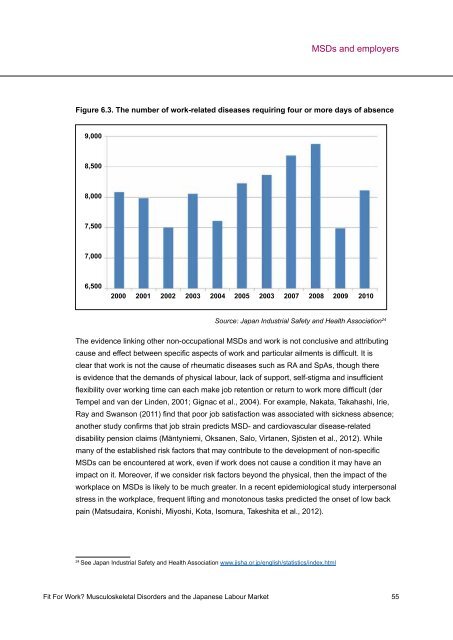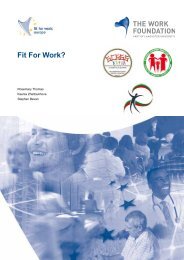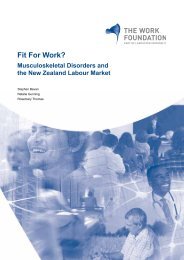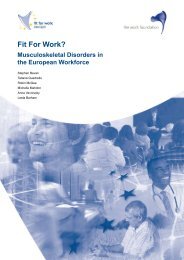English version - Fit for Work Europe
English version - Fit for Work Europe
English version - Fit for Work Europe
You also want an ePaper? Increase the reach of your titles
YUMPU automatically turns print PDFs into web optimized ePapers that Google loves.
Source: Japan Industrial Safety and Health Association 24<br />
The evidence linking other non-occupational MSDs and work is not conclusive and attributing<br />
cause and effect between specific aspects of work and particular ailments is difficult. It is<br />
clear that work is not the cause of rheumatic diseases such as RA and SpAs, though there<br />
is evidence that the demands of physical labour, lack of support, self-stigma and insufficient<br />
flexibility over working time can each make job retention or return to work more difficult (der<br />
Tempel and van der Linden, 2001; Gignac et al., 2004). For example, Nakata, Takahashi, Irie,<br />
Ray and Swanson (2011) find that poor job satisfaction was associated with sickness absence;<br />
another study confirms that job strain predicts MSD- and cardiovascular disease-related<br />
disability pension claims (Mäntyniemi, Oksanen, Salo, Virtanen, Sjösten et al., 2012). While<br />
many of the established risk factors that may contribute to the development of non-specific<br />
MSDs can be encountered at work, even if work does not cause a condition it may have an<br />
impact on it. Moreover, if we consider risk factors beyond the physical, then the impact of the<br />
workplace on MSDs is likely to be much greater. In a recent epidemiological study interpersonal<br />
stress in the workplace, frequent lifting and monotonous tasks predicted the onset of low back<br />
pain (Matsudaira, Konishi, Miyoshi, Kota, Isomura, Takeshita et al., 2012).<br />
24 See Japan Industrial Safety and Health Association www.jisha.or.jp/english/statistics/index.html<br />
MSDs and employers<br />
Figure 6.3. The number of work-related diseases requiring four or more days of absence<br />
9,000<br />
8,500<br />
8,000<br />
7,500<br />
7,000<br />
6,500<br />
2000 2001 2002 2003 2004 2005 2003 2007 2008 2009 2010<br />
<strong>Fit</strong> For <strong>Work</strong>? Musculoskeletal Disorders and the Japanese Labour Market 55







